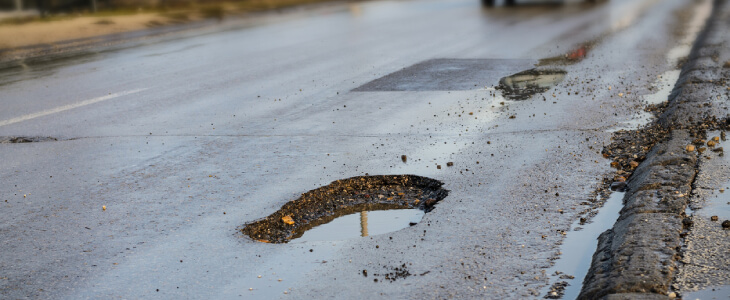Roads are an essential part of our daily lives, and as a result, their condition can significantly impact the safety and efficiency of travel. Damaged roads, characterized by potholes, uneven surfaces, and lack of proper signs, pose a substantial risk to drivers, cyclists, and pedestrians alike. The issue of responsibility for accidents on these damaged roads is complex because there is an interplay of maintenance by the municipalities, driver awareness, as well as the condition of the vehicle. As accidents occur, the question arises: Who is truly at fault when a car swerves to avoid a pothole or loses control on an uneven surface?
Considerations When Determining Responsibility Due To Road Damage
Some key points to consider when determining responsibility for personal injury cases due to road damage in Pennsylvania are as follows:
- Nature of Road Damage: The type of road damage can influence who is responsible should an accident occur as a result of the damage. The specifics of the damage can indicate if it was a state, county, or city responsibility.
Damage to roads can significantly contribute to accidents in several ways:
- 1) Potholes and Uneven Surfaces: Potholes and uneven road surfaces can cause drivers to lose control of their vehicles, especially at high speeds. This can lead to skidding, swerving, and collisions with other vehicles or objects.
- 2) Reduced Traction: Damaged roads can reduce the traction between the tire and the road surface, increasing the risk of accidents. This is particularly hazardous in wet or icy conditions, where the grip on the road is already compromised.
- 3) Unexpected Obstacles: Damage such as cracks, holes, or loose debris can create unexpected obstacles for drivers. Swerving to avoid these can lead to accidents, particularly if the maneuver is sudden or if it takes the vehicle into another lane.
- 4) Increased Wear and Tear on Vehicles: Consistent driving on damaged roads can lead to increased wear and tear on vehicles, potentially causing mechanical failures that can result in accidents. For example, a damaged suspension system or tire blowouts can make a vehicle difficult to control.
- 5) Distraction and Stress for Drivers: Navigating through damaged roads requires more attention and can be stressful for drivers. This added stress can lead to distraction and a reduced ability to react to other road hazards or changes in traffic conditions.
- 6) Impaired Visibility: In some cases, road damage can impair visibility – for instance, water pooling in potholes can splash onto windshields, or debris can obstruct a driver’s view.
- 7) Increased Braking Distance: Damage to the road surface can also affect the braking distance of a vehicle. If a driver is not aware of the road’s condition, they may not brake in time to avoid an obstacle or a sudden stop in traffic.
- 8) Cycling and Motorcycling Hazards: For cyclists and motorcyclists, road damage poses an even greater risk due to the smaller size and less stable nature of these vehicles. A pothole or a patch of gravel can easily cause a cyclist or motorcyclist to fall, potentially leading to serious injuries.
In order to reduce the risks of accidents occurring due to road conditions, regular road maintenance and prompt repairs of any damage are crucial. Additionally, drivers should be aware of the condition of the roads they are using and adjust their driving style accordingly. An example of a driver’s adjustment would be slowing down and allowing more distance between vehicles.
- Governmental Responsibility: Roads are usually maintained by different levels of government (state, county, or local). In Pennsylvania, entities like PennDOT (Pennsylvania Department of Transportation) could be responsible for state-maintained roads. Local municipalities are responsible for local roads.
- Notice of the Hazard: A critical factor is whether the responsible entity knew or should have known about the road damage. If it can be proven that they were aware of the hazard and did not take reasonable steps to fix it, they might be held liable.
- Sovereign Immunity: Government entities in Pennsylvania, as in many states, enjoy sovereign immunity, which can limit or exempt them from liability in certain situations. However, there are exceptions, particularly if gross negligence is involved.
- Statute of Limitations: In Pennsylvania, the statute of limitations for filing a personal injury lawsuit is two years. However, the time limit for filing claims against governmental entities is generally shorter than for other personal injury claims. If your claim involves a city, county, or state government agency in Pennsylvania, you have just six (6) months from the date of injury to file a notice of intent to sue. You would then have two years from the date of your injury to file your personal injury lawsuit against the government. Failing to send the required notice of intent would likely result in your lawsuit being dismissed.
- Contributory Negligence: In some cases, the injured party’s actions might also be considered. If the injured party’s negligence contributed to the accident, it could affect the claim.
- Evidence and Documentation: Collecting evidence such as photographs of the road damage, accident reports, and witness statements can be crucial in establishing responsibility.
Consulting with a personal injury attorney who is knowledgeable about Pennsylvania laws and precedents is important. The law firm of Cooper, Schall & Levy can provide guidance on the viability of a claim, the appropriate entity to sue, and the legal process. We can offer skilled advice tailored to your particular case.


